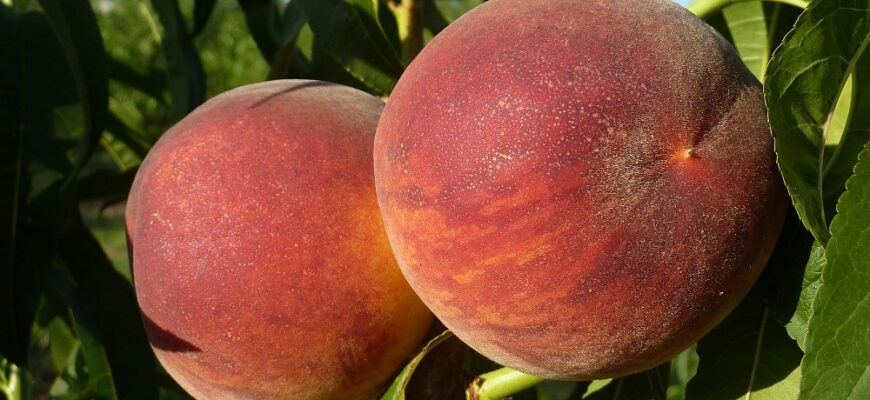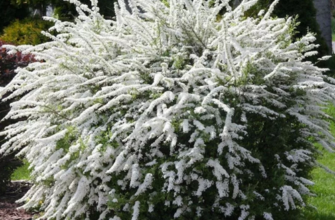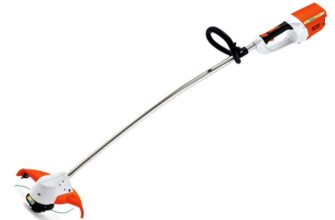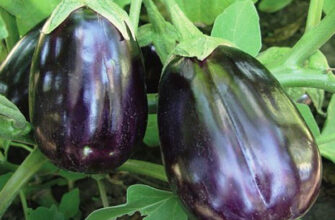Review of the best according to the editorial board. On the selection criteria. This material is subjective and does not constitute advertising and does not serve as a purchase guide. Before buying, you need to consult with a specialist.
Not so long ago, peaches were a rarity at their summer cottage. But today, many gardeners do not give up their attempts to grow different varieties of this stone fruit crop. In the Southern regions, it is much easier to approach the tender peach. And in areas of the middle and northern strip, this thermophilic culture requires special care and a more careful selection of suitable varieties.
In summer cottages, tree or shrub forms of this fruit crop are often grown. Usually they reach 3-4 m in height, but individual specimens can grow up to 8-9 m. Some species of this plant need a pollinator. The shelf life of these fruits usually does not differ in duration.
Fresh fruits can delight gardeners from July to the end of September, if you plant different varieties (early, medium, late) on your garden plot. To grow a high-quality crop, you need to choose the right variety of this crop for your region, taking into account the composition of the soil, climate and other criteria. In this review, we've compiled the best early, mid and late peach varieties.
- Rating of the best peach varieties
- The best early peach varieties
- Harrow Diamond
- Advantages
- disadvantages
- Spring Gold
- Advantages
- disadvantages
- Rich May
- Advantages
- disadvantages
- Collins
- Advantages
- disadvantages
- Novoselkovsky
- Advantages
- disadvantages
- Sugar Time
- Advantages
- disadvantages
- The best medium and late peach varieties
- Earley Red
- Advantages
- disadvantages
- Royal Glory
- Advantages
- disadvantages
- Red Haven
- Advantages
- disadvantages
- Cardinal
- Advantages
- disadvantages
- Veteran
- Advantages
- disadvantages
- Kremlin
- Advantages
- disadvantages
- Aliblanca
- Advantages
- disadvantages
- Fleming Fury
- Advantages
- disadvantages
- Frost
- Advantages
- disadvantages
Rating of the best peach varieties
| Nomination | a place | Variety | rating |
| The best early peach varieties | 1 | Harrow Diamond | 5.0 |
| 2 | Spring Gold | 4.9 | |
| 3 | Rich May | 4.8 | |
| 4 | Collins | 4.7 | |
| 5 | Novoselkovsky | 4.6 | |
| 6 | Sugar Time | 4.5 | |
| The best medium and late peach varieties | 1 | Earley Red | 5.0 |
| 2 | Royal Glory | 4.9 | |
| 3 | Red Haven | 4.8 | |
| 4 | Cardinal | 4.7 | |
| 5 | Veteran | 4.6 | |
| 6 | Kremlin | 4.5 | |
| 7 | Aliblanca | 4.4 | |
| 8 | Fleming Fury | 4.3 | |
| 9 | Frost | 4.2 |
The best early peach varieties
The first fruits of early peach varieties can be tasted in mid-June. And the harvest ripens completely in the second half of July.
Harrow Diamond
Rating: 5.0
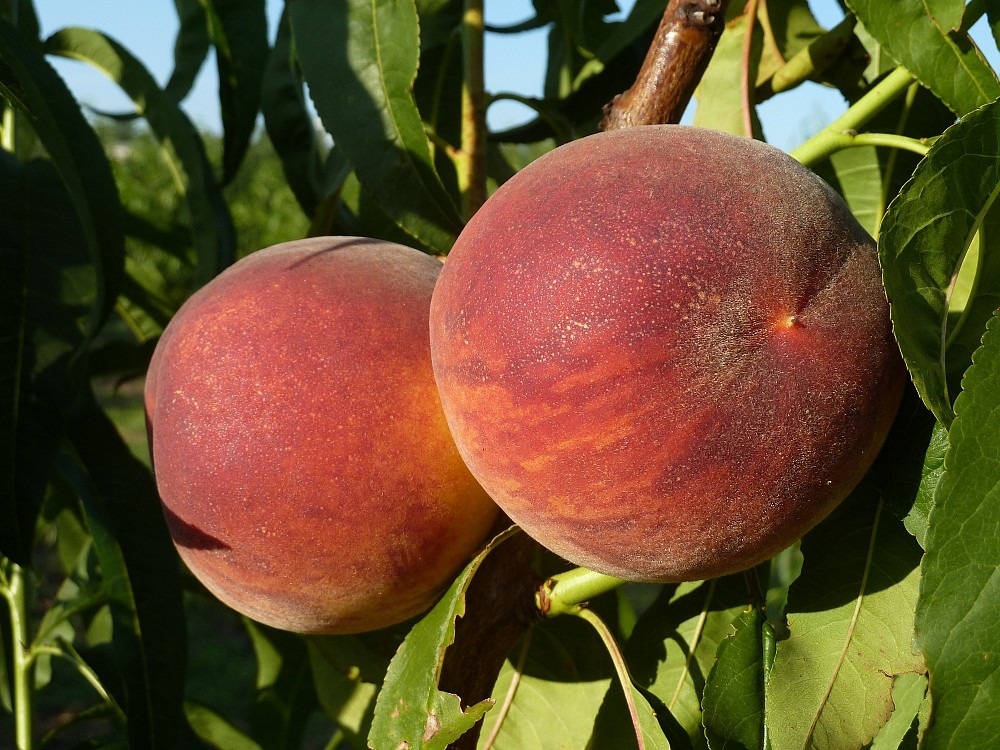
The early ripe Harrow Diamond peach variety belongs to the Canadian selection. It is a rather high (3-4 m), strongly thickened tree. The branches in the upper part of the plant are spreading. The leaves are lanceolate and have denticles along the edge. The pink flowers are formed from five petals and appear before the leaves open. Harrow Diamond is fully ripe in July. The crop can be harvested on three-year-old plants.
Harrow Diamond's fruits are oval, elongated, rather symmetrical. Their weight can reach 90-150 g. There is a yellow blush on the red skin. There is a groove on one side of the fruit. The pubescence is poorly expressed. The pulp is orange in color with red veins. It is fibrous, very juicy. The stone is brown, tough, separates from the pulp practically without problems. Harrow Diamond has a pleasant sweet-sour taste.
Gardeners love this variety and praise it in their reviews for being able to withstand severe frosts. They also like that Harrow Diamond peaches do not crack in high humidity or heavy rain. Still, the fruits do not immediately spoil their appearance after harvesting and are rather well transported. Harrow Diamond has won many followers for its balanced taste.
Advantages
- early ripening of the crop;
- balanced taste;
- the bone is almost completely separated from the pulp;
- does not crack at high humidity;
- high frost resistance;
- well transported.
disadvantages
- not detected.
Spring Gold
Rating: 4.9

Spring Gold, an early American peach variety, ripens from the end of June, and this process takes over part of July. The trees grow quite tall and have a compact crown. The plant is covered with pink-type flowers. Spring Gold is classified as industrial. Safely transfers transportation to local markets. This peach has high yields.
Spring Gold has medium-sized fruits (120-170 g). Their shape is slightly elongated, and their color is bright red. Outwardly, these fruits look very attractive. The pulp is fleshy and has a bright yellow color. This peach is fragrant and has a balanced taste. The bone practically does not separate from the pulp. The skin is medium in density and thickness, with velvety pubescence. It can be easily removed from the fetus.
According to reviews, in 6 years of fruiting, up to 52 kg of peaches can be harvested from one Spring Gold tree. Winter hardiness and drought resistance of this variety are average, heat resistance is above average. During flowering, Spring Gold is resistant to spring frost. The plant has good immunity, but it is still affected by curly and black spot.
Advantages
- high yield rates;
- early ripening;
- taste characteristics;
- good tolerance to frost and drought;
- safely transported.
disadvantages
- the bone practically does not separate from the pulp.
Rich May
Rating: 4.8

Peach Rich May belongs to the early varieties of American selection. Ripening begins in the 20th of June with a transition to early July. Trees grow up to 3 m in height. Their upper part is spherical. The plant grows strong and produces a bountiful harvest. Fruiting begins from the 2nd year. The variety can be grown for yourself and for sale.
Rich May is distinguished by very large (220-300 g) spherical fruits. In addition, they persist for quite a long time after collection and have an increased immunity to major diseases. Ripe fruits are colored maroon, and their flesh is yellow in section. These fruits have great taste and aroma. The taste is dominated by sweetness and they are very juicy. When fully ripe, the bone is freely separated.
Gardeners in reviews recommend planting seedlings of this plant in sunny areas and watering them moderately. Rich Mei has high frost resistance and disease resistance. This peach produces a stable harvest. The fruits are highly marketable and are excellent for long-distance transportation. The variety can be grown comfortably in many regions.
Advantages
- high-yielding industrial grade;
- excellent taste characteristics;
- the bone easily falls behind the pulp;
- high frost resistance;
- good immunity to major diseases of culture.
disadvantages
- not detected.
Collins
Rating: 4.7
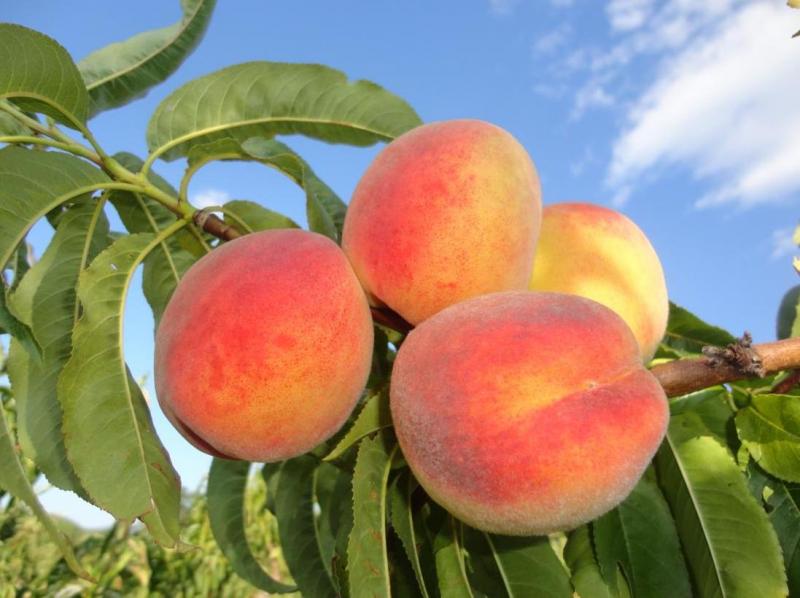
The American Collins peach is a mid-early variety. Trees grow up to 3 m in height. The top of the plant forms a ball shape. The branches have an average number of leaves. At the stage of budding, goblet-shaped flowers are formed. They have 5 petals of light pink color. The average diameter of a blossoming flower reaches 2.8 cm. The plant is self-fertile (pollinators are not needed to set the crop).
Collins' fruit is round. By weight, they can reach 100-150 g. Peaches have an orange-yellow color with a crimson blush. There is slight pubescence on the skin, and it itself is easily separated from the ripe fruit. The middle is very soft and juicy. It is sweet and very aromatic. To separate the bone from the pulp, you need to apply moderate effort.
Reviews about Collins are mostly positive. Consumers love the high yield of these peaches and the fact that they can be transported over long distances with careful transportation. This peach tree has excellent powdery mildew resistance and frost tolerance down to -20 ºC. But his immunity to many diseases is rather weak.
Advantages
- high productivity;
- sweet, aromatic peaches;
- tolerate transportation well;
- the variety does not need pollinators;
- tolerates drought well;
- not afraid of powdery mildew.
disadvantages
- the bone is separated with effort;
- weak immunity to many diseases.
Novoselkovsky
Rating: 4.6
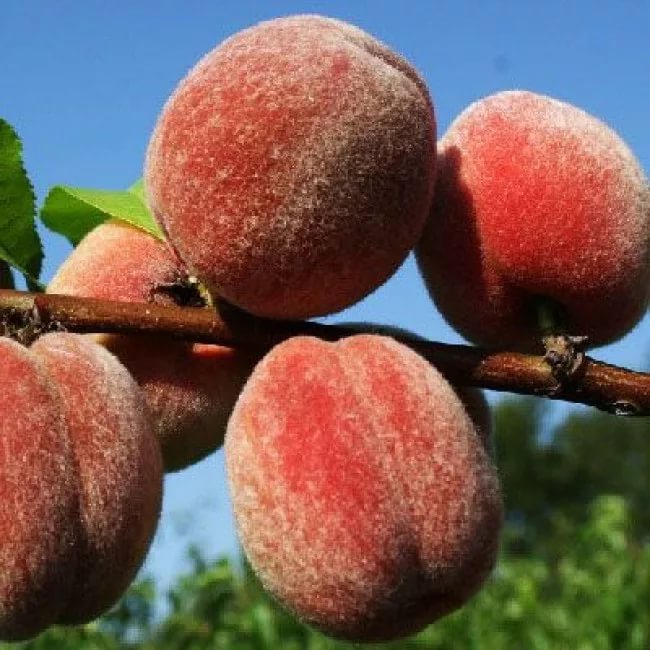
The medium-early Novoselkovsky peach variety belongs to the table. The tree grows poorly to medium. It has a rounded top. The first crop can only be harvested 4-5 years after planting. Although in some specimens, single fruits appear already for 2-3 years. In the presence of a pollinator, it is possible to achieve high yields.
Novoselkovsky is given medium (50-60 g) fruits by weight. Round peaches have a dividing groove. Their skin is creamy white, with a faint striped blush that appears on the side facing the sun. The delicate pulp is characterized by a sweet taste with a slight sourness. The medium-sized bone practically does not lag behind the pulp.
According to reviews, Novoselkovsky is a worthy representative of winter-hardy varieties. It recovers well even after the harshest winters. This variety has good disease resistance, especially leaf curl. Novoselkovsky loves light and warmth. These peaches are great for versatile use.
Advantages
- pollinators increase yields;
- recovers well after freezing;
- good resistance to disease;
- the pulp is very tender and sweet.
disadvantages
- fruiting you need to wait 4-5 years;
- the bone is not separated from the pulp.
Sugar Time
Rating: 4.5
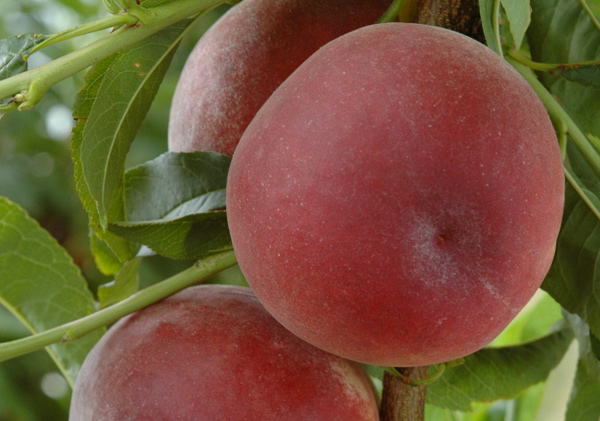
A new early peach variety of American selection Sugar Time (“Sugar Time”) ripens by June 25-30. The tree grows strongly and has high productivity. Recommended for cultivation in industrial plantings, as well as in private plots. Sugar Time is valued for its high marketability and safety during transportation.
The average weight of Sugar Time fruits is 170-240 g. They are rounded and almost completely covered with a red blush. Their pubescence is minimal. The pulp has a fairly dense texture and yellow color. These peaches have a distinct aroma. The taste is sweet with honey notes. Sugar Time bears fruit constantly and in large quantities.
Gardeners speak very well of Sugar Time peaches. They note that the seedlings of this plant take root quickly and are easily cultivated. This variety of peaches is relatively resistant to fungal diseases. Plants have high winter hardiness. This peach can be transported over long distances.
Advantages
- ripens early;
- gives stable, large yields;
- delicious, aromatic peach;
- well transported;
- has high frost resistance.
disadvantages
- not detected.
The best medium and late peach varieties
Later varieties of peach are planted by those who want to harvest from the second half of summer to early fall.
Earley Red
Rating: 5.0
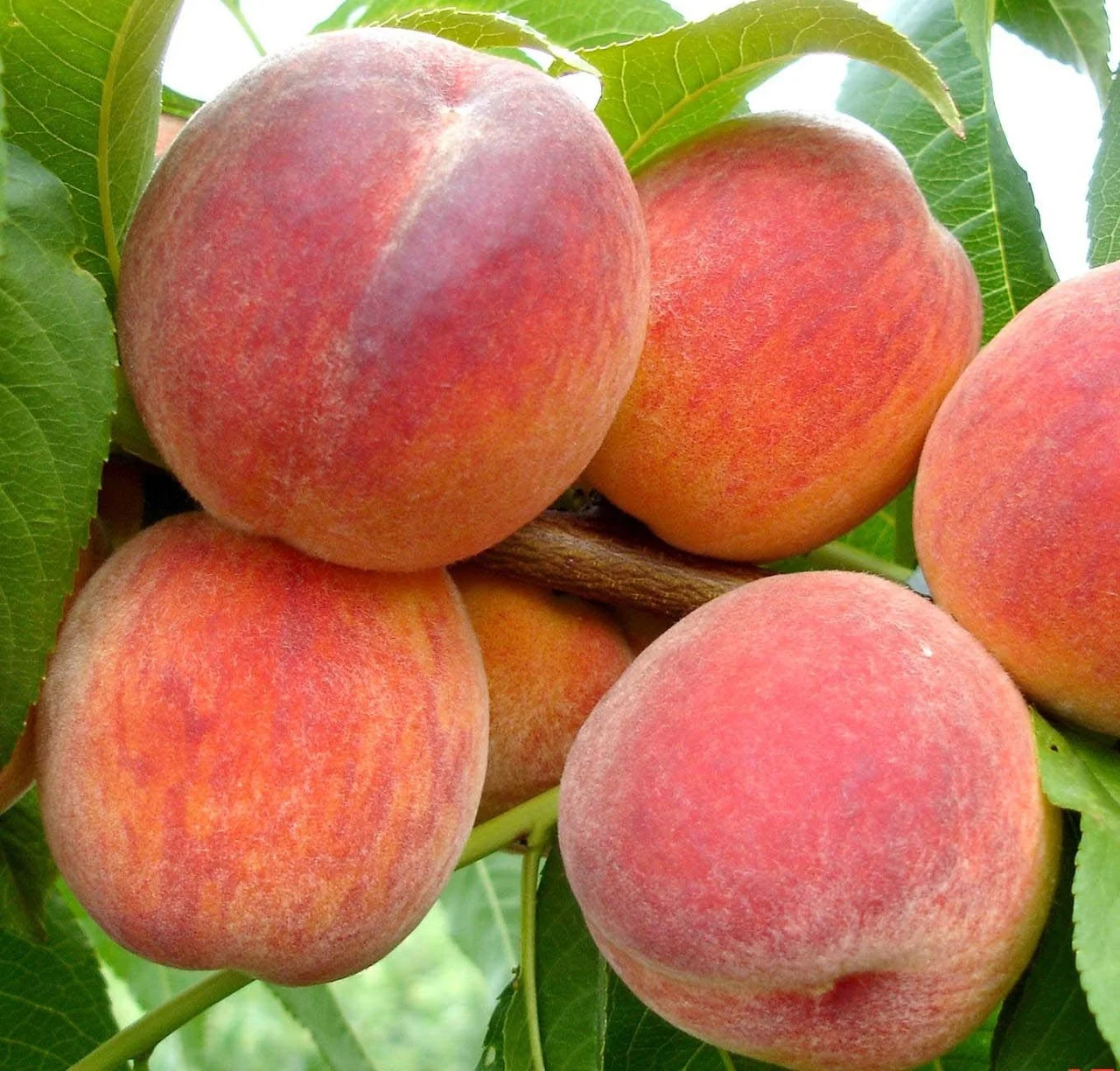
A medium early peach variety, Earley Red, begins to ripen in the first half of July. The tree grows to a height of 3 m. It is compact and belongs to perennials. The crown is flat-rounded in shape with medium foliage. The oblong leaves are green and have a serrated border. Even before their dissolution, the plant is abundantly covered with pink flowers.
Airlie Red's fruits are large (from 150 to 200 g). Their color is carmine-burgundy. The pulp is juicy and tender with pronounced fibers. Her color is yellow with a pink tint. The peel is slightly pubescent. The bone has characteristic grooves and dimples. It is colored brown. The bone lags behind the pulp without much effort. This plant begins to bear fruit in the 3rd year after planting.
From the gardeners' reviews, it becomes obvious that Airlie Red has good immunity to the main diseases of this culture. Also, the variety shows good frost resistance, has a high yield and is safely transported and stored. This variety can be grown both for yourself and for an industrial scale.
Advantages
- begins to ripen in the first half of July;
- high taste characteristics;
- the bone is easily separated from the pulp;
- well transported;
- has good immunity.
disadvantages
- bears fruit only from the 3rd year.
Royal Glory
Rating: 4.9

A worthy representative of the American selection of Floyd Seiger is the Royal Glory peach. The ripening period differs in different years. But often this process begins in the 10-25th of July. The trees grow quite tall (up to 4.2 m). They are slightly spreading. The variety is partly self-fertile. The harvest begins to give soon and in large quantities.
Royal Glory peaches reach 150-200 g in weight. They are round in shape and completely covered with a purple-cherry blush. Moreover, it appears regardless of the amount of direct sunlight or the location of the fruits on the trees. The peel is slightly pubescent. The pulp is orange in color. She has an average density. It is juicy and fragrant. The taste is dominated by sweetness. The bone is difficult to separate from the pulp.
According to reviews, the Royal Glory peach keeps well during transportation. It can stay in the refrigerator for 7-10 days, keeping its commercial qualities. Its gustatory characteristics are beyond praise. This peach has good immunity to major diseases. It has a very high yield if the tree is timely looked after and pruned.
Advantages
- one of the best varieties in terms of taste;
- high productivity;
- well transported;
- high resistance to disease;
- partially self-fertile variety.
disadvantages
- the bone is separated with difficulty.
Red Haven
Rating: 4.8

Among the American selection, the Red Haven peach takes pride of place. It is medium in terms of ripening. The tree reaches an average height. Its upper part is perfectly formed. Their life expectancy is long. This plant blooms in April and can be harvested in the second half of July. Active fruiting begins in the 4th year of life.
At Red Haven, the average weight of fruits reaches 120-160 g. And if sufficient soil moisture is provided, then this figure reaches 200 g. The pulp becomes creamy with an orange tint when the peach reaches biological maturity. They are sweet and juicy. Their peach aroma is pronounced. The stone is small, elongated and has a pointed end. It is not difficult to separate it from the pulp. The skin is velvety with a bright raspberry color.
Gardeners speak very well of the Red Haven peach. They like the high marketability and transportability of these fruits. They can be stored for 5-7 days without losing their attractive appearance and taste. They also note a high yield – up to 40-50 kg of peaches can be removed from one tree. The plant has good frost resistance.
Advantages
- tasty and juicy fruits;
- no need for a pollinator;
- good tolerance to low temperatures;
- high yield rates;
- well transported and stored;
- the bone is easily separated from the pulp.
disadvantages
- begins to bear fruit in the 4th year of life.
Cardinal
Rating: 4.7
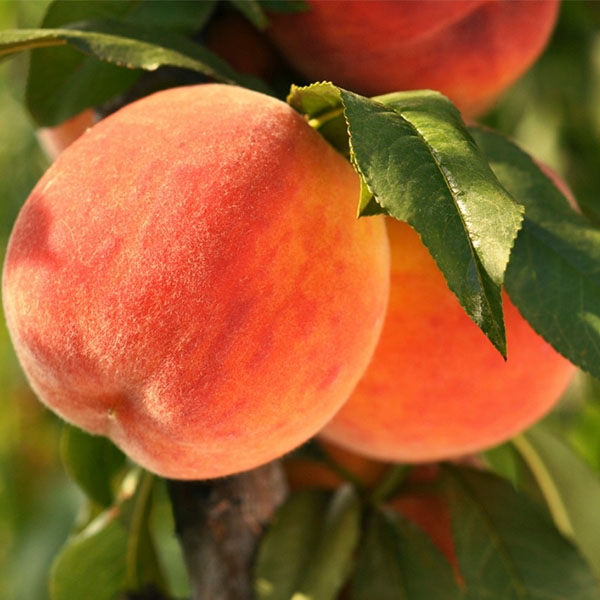
The medium-late Cardinal peach begins to ripen in the second half of summer. Self-fertile fruit of this variety forms medium-sized trees. The upper part of the plant is very lush and rounded. Young shoots grow quickly, so the tree needs to be cut regularly. Cardinal begins to bear fruit 2-3 years after planting. Produces a good harvest consistently.
Round, slightly flattened Cardinal peaches weigh on average 120-150 g. Their skin is yellow with a dotted carmine blush. The pulp is juicy and fibrous with a light sandy tint. These peaches are not sugary. They are sweet with an appropriate sourness. Moreover, Cardinal is very aromatic. A small bone is difficult to separate from the pulp.
Gardeners note that the Cardinal peach is quite unpretentious to care for. For its successful cultivation, it is enough to adhere to the rules common to fruit trees. The transportability of these fruits is high. The plant has a high immunity to powdery mildew. However, Cardinal's curliness is often struck. He has average winter hardiness.
Advantages
- the plant is not capricious in care;
- the fruits are tasty and beautiful;
- the yield is stable, high;
- good transportability;
- not afraid of powdery mildew.
disadvantages
- the bone from the pulp lags poorly;
- quite often it is affected by curliness.
Veteran
Rating: 4.6

The old Canadian Veteran peach variety is still popular. The tree does not exceed 4 m in height. The top of the plant resembles a ball in shape. The crown is very dense. The plant is self-fertile, but the presence of other varieties of peach trees nearby slightly increases the yield. The main crop can be harvested from mid-August. It is possible to harvest up to 45-50 kg of fruits from one mature tree.
Veteran's rounded peaches reach 160 g in weight. Their color is bright yellow with a red blush, which covers almost the entire surface of ripe fruits. Their flesh is yellowish. It is quite dense, juicy and very aromatic. The taste is more sweet, but there is also sourness. You can harvest the crop already in the third year after planting, but it is better to do it for 5-6 years, so that the plant has already fully developed.
According to reviews, Veteran peach trees are hardy, but afraid of severe frosts. They can withstand temperatures as low as -20–22 ° C, but damage to the buds, flower ovaries and roots located in the upper soil layer is possible. The plant has good immunity, but it is attacked by aphids. Veteran peaches are quite well transported over long distances and are well stored.
Advantages
- taste at a high level;
- up to 50 kg of fruits can be harvested from one tree;
- self-pollination;
- has good immunity;
- well transported over long distances.
disadvantages
- attacked by aphids;
- it is recommended to harvest the crop only for 5-6 years.
Kremlin
Rating: 4.5
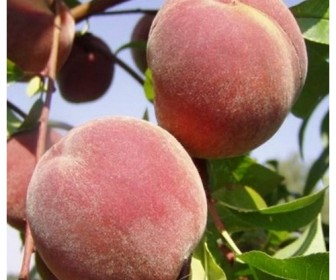
The Kremlin peach variety belongs to the late varieties. The tree grows strongly. Its upper part is wide-spreading and has an oval shape. The branches are actively growing, so it is important to timely control their density and cut them off in time. During frosts, flower buds can freeze. You can harvest peaches of this variety in the 4th year. The fruits ripen in late summer.
Kremlin peaches have a rich yellow color with a coral blush on one of the sides. They are quite sweet and tender. The pulp is medium in density, moderately juicy, with a delicate peach aroma. Fruit weight reaches 150-200 g. There is a slight pubescence on the skin. It is soft and velvety. The stone is medium, oval.
Gardeners in their reviews note that they really like the taste of these fruits, but they do not tolerate transportation very well. One peach tree can be harvested up to 40 kg. But such indicators are not constant and depend on the climatic conditions of the region of growth and the current weather conditions. Disease tolerance in the Kremlin variety is above average.
Advantages
- yield indicators at a high level;
- the fruits are quite large;
- moderately juicy, tasty fruits;
- disease resistance above average.
disadvantages
- poorly stored and transported;
- inconstancy of fruiting.
Aliblanca
Rating: 4.4
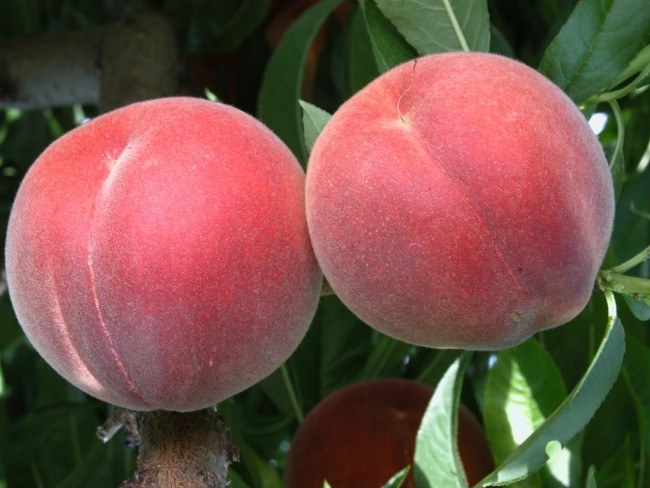
Aliblanca peach belongs to the late varieties of Italian selection. It is a tree with a vigorous growth rate. Fruiting is stable. Fruits ripen in the first half of September. The variety is particularly resistant to many adverse factors. It is quite possible to cultivate it in regions with colder climates.
Fruits in Aliblanca are round in shape, weighing about 200 g. A bright red blush occupies a large area of a peach. The pulp is delicious. It has a balanced sweetness and acidity. Her density is average. It is white, and pink veins are visible closer to the bone. The bone is not fused with the pulp. Fruits perform well enough in maturation and during transportation.
According to reviews, the Aliblanca peach is very picky to care for. However, after planting, the plant requires mandatory watering. Aliblanca has good resistance to curliness and other diseases. The plant has good frost resistance. Many people prefer this peach because it has a great taste and good marketability.
Advantages
- resistant to adverse factors;
- practically does not get sick;
- great taste;
- the bone separates well from the pulp;
- well transported.
disadvantages
- not identified.
Fleming Fury
Rating: 4.3
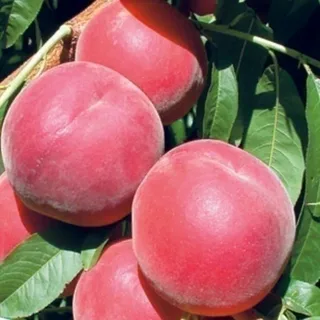
A mid-late American-bred Fleming Fury peach variety ripens towards early autumn. The trees are growing a lot. They are characterized by increased resistance to frost. The upper part of the plant is spreading, slightly wide. The variety is very unpretentious to grow. Suitable for cultivation in various regions.
The fruits of the Fleming Fury variety are quite large (average weight – 200 g). Their shape is round, orange color. A deep red blush occupies most of the fruit surface. The pulp has a yellow-orange color. She is very juicy and tender. Its taste is assessed as high. The bone is not fused with the pulp. The plant begins to bear fruit in 3-4 years.
Gardeners note that Fleming Fury has above average winter hardiness. And his yield is very high. The fruits are transportable, high-quality. The plant has absolute resistance to leaf infections. Fleming Fury is appreciated for the high taste and appearance of the fruit.
Advantages
- taste of peaches at a high level;
- good in prone;
- well transported over long distances;
- the bone lags well behind the pulp;
- good immunity.
disadvantages
- fruiting occurs in 3-4 years.
Frost
Rating: 4.2
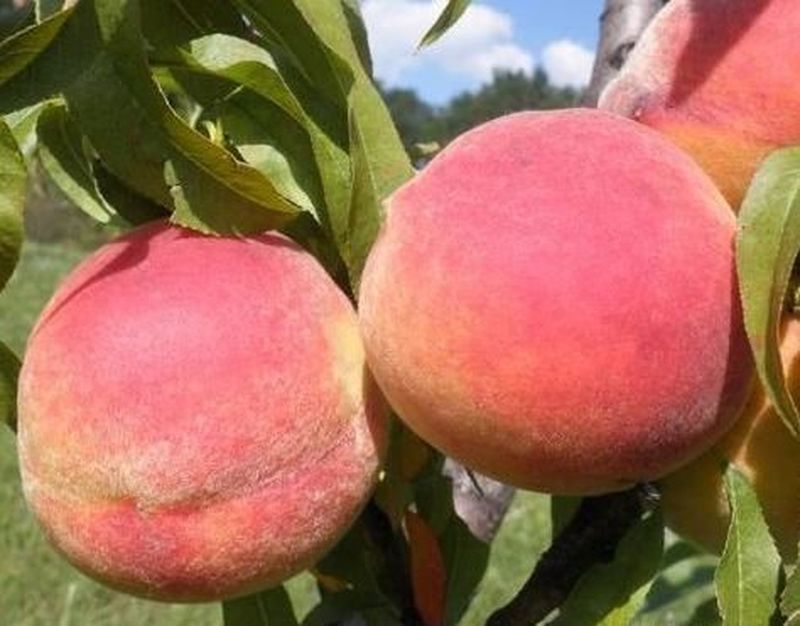
Frost, ripening at the end of summer, is a medium-late variety. The tree grows medium. Fruiting begins in the second year after planting. In terms of taste, it has practically no equal in the world. Suitable for cultivation in various regions. Doesn't need pollinators.
Large (180-200 g) fruits have a rich red color. Slight pubescence is present on the skin. The fruits smell very nice. A slight sourness is felt in the taste, but sweetness dominates. In the context of the Frost peaches are yellow-orange. Their flesh is very juicy and tender. The bone is not fused with it and is easily separated from it.
According to gardeners' reviews, Frost peach is declared frost tolerant to -30 ºC, which is a critical temperature for other varieties. The cultivar has good resistance to powdery mildew and is rarely affected by leaf infections. The fruits are well stored (due to the dense skin) and are freely transported over long distances.
Advantages
- one of the most delicious varieties;
- does not need pollinators;
- shows itself well during storage;
- can be transported over long distances;
- frost tolerance down to -30 ºC;
- the bone is not fused with the pulp.
disadvantages
- not identified.
Attention! This rating is subjective and does not constitute an advertisement and does not serve as a purchase guide. Before buying, you need to consult with a specialist.

